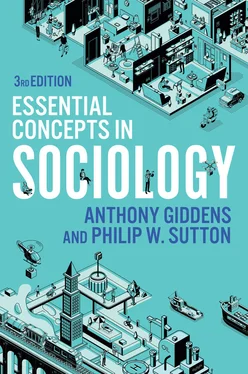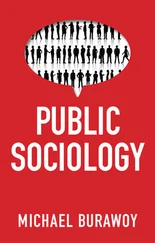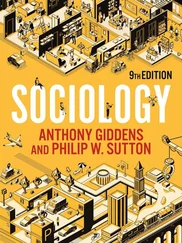The entries are more substantial than usual for a typical ‘key concepts’ book, most of which aim to be comprehensive in coverage, but with brief entries. Our aim instead is to provide an extended discussion of each concept, setting each one into its historical and theoretical context, exploring its main meanings in use and introducing relevant criticisms, before pointing readers to contemporary pieces of research and theorizing which they can follow up themselves. This structure enables readers to link the history of sociology with its contemporary form through the development of its key concepts. Readers are advised to use the Index as a guide for locating the many other concepts embedded within the text that do not appear in the Contents list.
As with all scientific disciplines, disagreement is both inevitable and necessary, so some of the concepts we have selected will, no doubt, be queried. Some will consider that we have missed a crucial concept or included others that have, in fact, become quite irrelevant. This is normal, even though it might strike some readers as odd that we quibble about such fundamental things as ‘essential’ concepts. However, sociology’s theoretical diversity means that there are varied theoretical commitments and perspectives which prioritize some concepts over others. Remember though, that, even if we do disagree, we still actually speak to and understand each other. And one reason why we are able to do that is because of our shared conceptual heritage, derived from the many theories and explanatory frameworks that have waxed and waned over the years.
The book’s entries are in ten major themes, internally listed alphabetically. As a quick reference guide, this helps readers to find what they are looking for. The book is also a stand-alone text that can be used by anyone looking to understand sociology’s essential concepts. Readers who also use our Sociology: Introductory Readings (2010) will appreciate that there is a matching structure across both books, facilitating cross-referencing of concepts with the associated readings by theme. Concepts are cross-referenced within the present text by highlighting in boldthe first use of other concepts within the individual entries. We have also taken a few liberties. For instance, raceand ethnicityare covered in one rather than two entries because the two are generally discussed together, though their key differences are made clear in the discussion. We decided to do something similar with structure/agencyand qualitative/quantitativemethods. Some entries may also be thought of as really theories or general perspectives rather than concepts. Globalization, for example, is both a concept and a theory of social change, while the social model of disabilityis a particular approach to studying disability in society. These are included so that the book will fulfil its purpose, namely, to provide an accurate and up-to-date conceptual map of contemporary sociology.
THEME 1Thinking Sociologically
Digital Revolution
Working Definition
From the mid-twentieth century, the shift away from analogue and mechanical technologies to digital electronics and computerized systems. In sociology, the concept covers all of the social, economic and cultural consequences of this expansive process of socio-technological change.
Theories of a digital revolution are still contested, but the origins of digitization are well established. A crucial turning point was the creation of ARPANET, forerunner to the internet. ARPANET was an experimental computer network, a product of the US Pentagon’s Advanced Research Projects Agency Network, which enabled scientists across the USA to communicate directly. From here the network was expanded for use in universities, research centres and business (Athique 2013: 13). By 1987, 28,000 computers in universities and research facilities were linked, but by 1994 businesses had become the main users. As the internet became available in private homes, a global multimedia library, the worldwide web (WWW) became its central feature. The advent of fast broadband at the turn of the century then made available many more opportunities for development.
Significant technological advances in the digitization of data over this period transformed telecommunications. The processing power of computers continuously increased, as did internet speeds, making possible video streaming, faster downloads and interactive media such as blogs, vlogs and globally accessible social media (Negroponte 1995). Online sites, such as Wikipedia, are typical of the interactive second generation of internet usage, known as Web 2.0. Four major technological trends underpin ongoing digitization: the continuous improvement of computer capabilities, the digitization of data, satellite communications infrastructure, and fibre optics allowing multiple messages along a single cable. The digital revolution also includes a myriad of digital devices that are now part of everyday life, including computers, tablets, smartphones, internet-enabled TV and the expanding Internet of Things, all made possible by wireless technology (Wi-Fi). Today, artificial intelligence (AI), robotics and ‘big data’ mark out the next phase of development, as we move a step closer to a world of automated factories, driverless cars, drone delivery systems, domestic robots and AI-generated journalism and teaching.
Meaning and Interpretation
As the examples above show, digitization facilitates a growing global connectivity that has transformed almost every aspect of life in most countries, raising serious questions as workplaces are transformed and workers see their jobs and roles digitally reshaped. Internet access has already become a necessity if people are to take advantage of the new opportunities it opens up. By 2019, some five and a half billion people had internet access, with the fastest growth rates since 2000 in Africa, the Middle East, Latin America, the Caribbean and Asia. As digitization has become embedded in social life, younger generations are the ‘digital natives’ socialized and comfortable in the era of the internet, robotics and AI.
Castells (2006, 2015) argues that we have created a networked, globalizing world which generates new forms of expression, sociability, cybercrimes, work, social movements and much more. Protests in Hong Kong in 2019 against legislative change and Extinction Rebellion’s 2019–20 direct actions on global warming made extensive use of social media, and reports of the protests were often live-streamed by activists themselves, illustrating Castells’s idea of ‘networked social movements’. Formerly discrete media forms have also become intertwined, in a merger process known as media convergence, with the internet at its centre. For instance, newspaper sales have declined, but news has moved online, while global video providers, such as Netflix, have transformed television watching with live-streaming and catch-up via smartphones and other devices.
For some, digitization also changes the character of capitalism and, with it, the world of work. A ‘gig economy’ has developed in which workers are treated as self-employed contractors, and firms operate as online platforms supplying ‘gigs’, absolving them of conventional employer responsibilities. Srnicek (2016) theorizes that we may be entering a period of ‘platform capitalism’ where data is the key resource for capitalist expansion – harvested, collated and used to improve services and products and to sell on at a profit. The danger is that this results in the erosion of privacy and confidentiality as the public–private boundary is further eroded. Zuboff (2019) theorizes the situation as one of ‘surveillance capitalism’, in which the enormous promise of the digital revolution is being lost to corporate interests. Surveillance capitalists exploit devices such as the Amazon Alexa, smart thermostats, speakers, routers and even home security devices, collecting data for analysis, predictions of consumer behaviour and, thus, increased sales. Indeed, intensified surveillance is a key theme in many studies of the digital age.
Читать дальше












